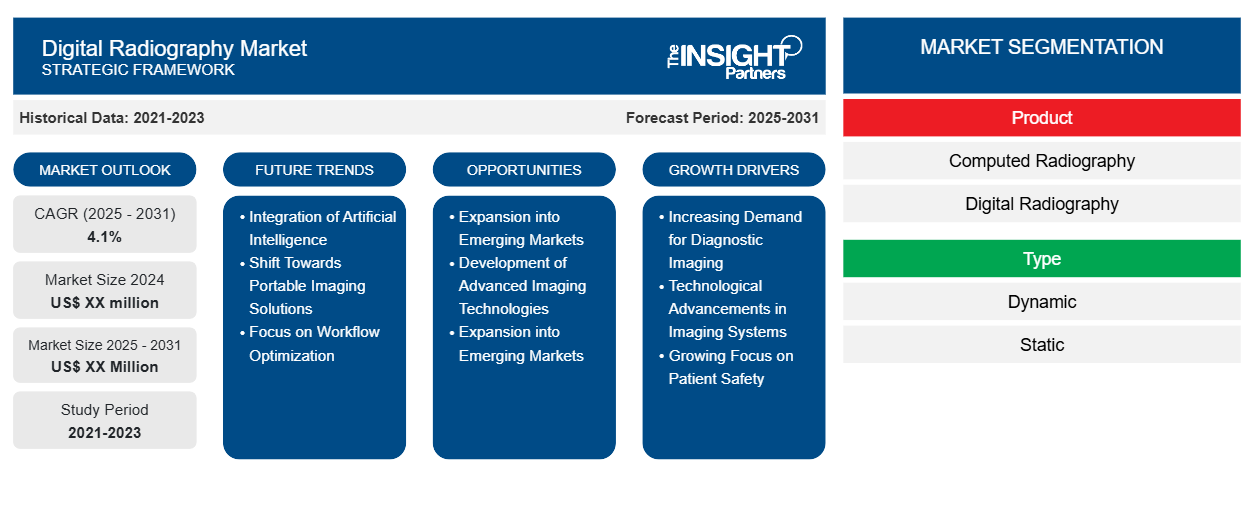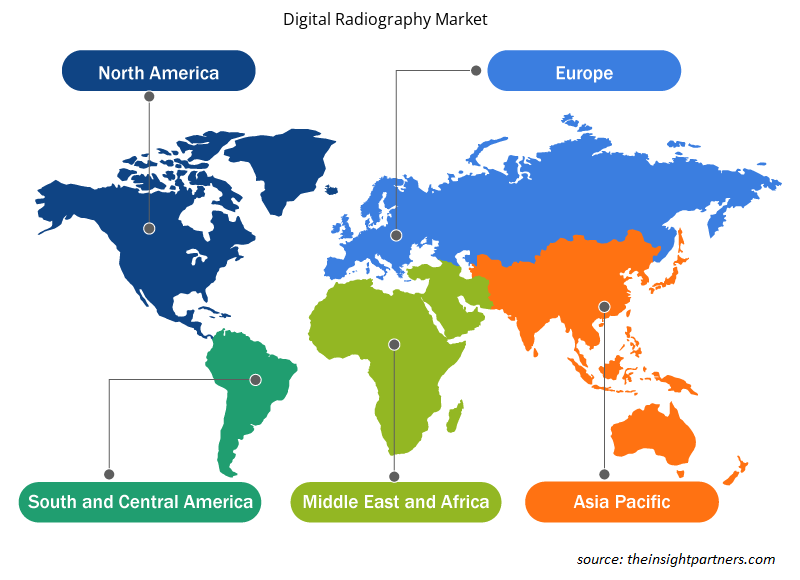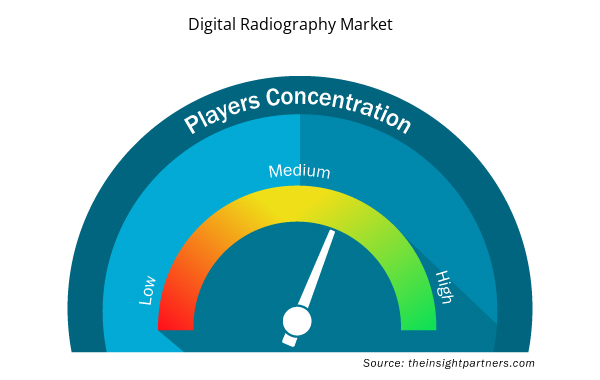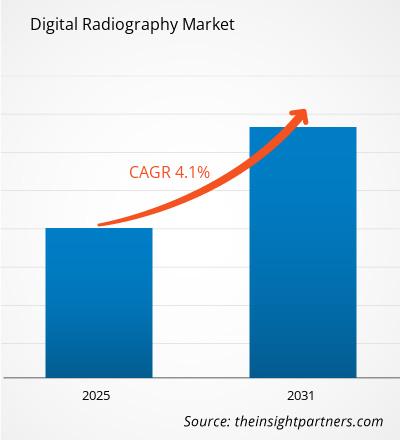Le marché de la radiographie numérique devrait enregistrer un TCAC de 4,1 % de 2025 à 2031, avec une taille de marché passant de XX millions USD en 2024 à XX millions USD d'ici 2031.
Le rapport est segmenté par produit (radiographie informatisée, radiographie numérique) ; type (dynamique, statique) ; application (radiographie générale, dentisterie, oncologie, orthopédie, autres) ; utilisateur final (hôpitaux, cliniques, centres de diagnostic, autres). L'analyse globale est ensuite subdivisée par région et par principaux pays. Le rapport présente la valeur en USD pour l'analyse et les segments ci-dessus.
Objet du rapport
Le rapport sur le marché de la radiographie numérique, publié par The Insight Partners, vise à décrire le paysage actuel et la croissance future, les principaux moteurs, les défis et les opportunités. Il fournira des informations aux différents acteurs du secteur, notamment :
- Fournisseurs/fabricants de technologies : pour comprendre l’évolution de la dynamique du marché et connaître les opportunités de croissance potentielles, leur permettant de prendre des décisions stratégiques éclairées.
- Investisseurs : réaliser une analyse complète des tendances concernant le taux de croissance du marché, les projections financières du marché et les opportunités qui existent tout au long de la chaîne de valeur.
- Organismes de réglementation : Réglementer les politiques et les activités de police sur le marché dans le but de minimiser les abus, de préserver la confiance des investisseurs et de maintenir l’intégrité et la stabilité du marché.
Segmentation du marché de la radiographie numérique
Produit
- radiographie informatisée
- radiographie numérique
Taper
- Dynamique
- Statique
Application
- Radiographie générale
- Dentisterie
- Oncologie
- Orthopédique
- Autres
Utilisateur final
- Hôpitaux
- Cliniques
- Centres de diagnostic
- Autres
Personnalisez ce rapport en fonction de vos besoins
Vous bénéficierez d'une personnalisation gratuite de n'importe quel rapport, y compris des parties de ce rapport, ou d'une analyse au niveau des pays, d'un pack de données Excel, ainsi que de superbes offres et réductions pour les start-ups et les universités.
Marché de la radiographie numérique : perspectives stratégiques

- Obtenez les principales tendances clés du marché de ce rapport.Cet échantillon GRATUIT comprendra une analyse de données, allant des tendances du marché aux estimations et prévisions.
Facteurs de croissance du marché de la radiographie numérique
- Demande croissante en imagerie diagnostique : La forte demande de radiographie numérique dans le secteur de la santé est alimentée par la demande croissante de solutions d'imagerie diagnostique. Un nombre croissant de patients souffrent de maladies chroniques et de blessures, et les professionnels de santé sont tenus d'établir des diagnostics précis et d'élaborer des plans de traitement grâce à des technologies d'imagerie avancées. La radiographie numérique offre des résultats plus rapides, des images de haute qualité et des doses de rayonnement plus faibles, ce qui en fait la modalité privilégiée des établissements médicaux modernes.
- Progrès technologiques des systèmes d'imagerie : Le marché de la radiographie numérique est fortement influencé par l'évolution rapide des technologies d'imagerie. De meilleurs détecteurs, des logiciels de traitement d'images performants et des fonctionnalités de télémédecine intégrées contribuent à rendre la radiographie numérique beaucoup plus efficace et facile à utiliser. Ces technologies améliorent non seulement la précision du diagnostic, mais simplifient également le travail dans les environnements de soins de santé, favorisant ainsi l'adoption de solutions de radiographie numérique.
- Priorité croissante à la sécurité des patients : Depuis l'importance croissante accordée à la sécurité des patients et à la réduction de l'exposition aux radiations, le marché de la radiographie numérique a fortement progressé. Les systèmes numériques introduisent de faibles doses de radiation par rapport aux méthodes sur film. Ainsi, la menace habituelle des radiations pour les patients et le personnel est atténuée. La prise de conscience croissante de l'importance de la sécurité des patients a entraîné une demande accrue pour la radiographie numérique.
Tendances futures du marché de la radiographie numérique
- Intégration de l'intelligence artificielle : L'intelligence artificielle est une autre tendance majeure du marché de la radiographie numérique. L'une des tendances les plus prometteuses du secteur est l'intégration de l'intelligence artificielle dans l'imagerie. Cette technologie permet d'améliorer l'analyse des images grâce à l'IA, rendant les diagnostics plus rapides et plus précis. Cette tendance améliore non seulement l'efficacité des flux de travail, mais aide également le radiologue à présenter de meilleurs résultats et à simplifier les processus diagnostiques.
- Évolution vers des solutions d'imagerie portables : Cette évolution vers des solutions d'imagerie portables modifie le paysage actuel du marché de la radiographie numérique. Indispensables à leur évolution vers une plus grande praticité et une plus grande accessibilité, les systèmes de radiographie numérique portables commencent à émerger dans les services d'urgence et les centres isolés. L'imagerie sur site permet d'améliorer la prise en charge des patients, de réduire les temps d'attente et d'améliorer l'accès aux services de diagnostic dans de nombreux endroits.
- Accent sur l'optimisation des flux de travail : L'optimisation des flux de travail est considérée comme gagnant en popularité sur le marché de la radiographie numérique en raison du besoin d'efficacité dans les établissements de santé. Les fabricants améliorent l'efficacité grâce à des systèmes qui simplifient les procédures d'imagerie, s'intègrent parfaitement au dossier médical électronique du patient et favorisent une meilleure communication entre les équipes soignantes. Cette tendance améliore non seulement l'efficacité opérationnelle, mais contribue également à une meilleure expérience diagnostique pour les patients.
Opportunités du marché de la radiographie numérique
- Expansion sur les marchés émergents : Cela ouvre d'importantes perspectives de croissance pour la radiographie numérique sur ces marchés émergents où les infrastructures de santé sont devenues un enjeu majeur. En effet, les efforts régionaux visant à moderniser les technologies médicales, ainsi que les capacités de diagnostic, devraient accroître la demande de solutions de radiographie numérique. Les entreprises qui s'aventurent sur ces marchés pourraient s'associer aux prestataires de soins de santé locaux et saisir ainsi des opportunités de croissance dans le secteur de la santé.
- Développement de technologies d'imagerie avancées : Les solutions d'imagerie avancées intégreront les nouvelles technologies numériques, notamment celles envisageables pour les nouvelles générations de radiographie numérique, ouvrant ainsi de nouvelles perspectives de développement. L'imagerie avancée permettra l'imagerie 3D, la radiographie bi-énergie et d'autres technologies de détection innovantes offrant des performances et des résultats diagnostiques améliorés. Les investissements en R&D consacrés à ces solutions de pointe inciteront les entreprises à aller encore plus loin et à repousser les limites de leurs offres actuelles pour répondre aux besoins constants des professionnels de santé.
- Expansion sur les marchés émergents : L'intégration des solutions de télésanté à la radiographie numérique ouvre un espace de développement du marché. Les progrès de la télémédecine peuvent accompagner l'élargissement des soins aux patients grâce à l'intégration des capacités d'imagerie et de consultation à distance. Ce marché en constante expansion pourrait être exploité par les entreprises qui développeraient des systèmes facilitant le partage des images radiographiques entre les différents professionnels de santé et les patients.
Aperçu régional du marché de la radiographie numérique
Les tendances et facteurs régionaux influençant le marché de la radiographie numérique tout au long de la période de prévision ont été analysés en détail par les analystes d'Insight Partners. Cette section aborde également les segments et la géographie du marché de la radiographie numérique en Amérique du Nord, en Europe, en Asie-Pacifique, au Moyen-Orient et en Afrique, ainsi qu'en Amérique du Sud et en Amérique centrale.

- Obtenez les données régionales spécifiques au marché de la radiographie numérique
Portée du rapport sur le marché de la radiographie numérique
| Attribut de rapport | Détails |
|---|---|
| Taille du marché en 2024 | XX millions de dollars américains |
| Taille du marché d'ici 2031 | XX millions de dollars américains |
| TCAC mondial (2025 - 2031) | 4,1% |
| Données historiques | 2021-2023 |
| Période de prévision | 2025-2031 |
| Segments couverts | Par produit
|
| Régions et pays couverts | Amérique du Nord
|
| Leaders du marché et profils d'entreprises clés |
|
Densité des acteurs du marché de la radiographie numérique : comprendre son impact sur la dynamique des entreprises
Le marché de la radiographie numérique connaît une croissance rapide, portée par une demande croissante des utilisateurs finaux, due à des facteurs tels que l'évolution des préférences des consommateurs, les avancées technologiques et une meilleure connaissance des avantages du produit. Face à cette demande croissante, les entreprises élargissent leur offre, innovent pour répondre aux besoins des consommateurs et capitalisent sur les nouvelles tendances, ce qui alimente la croissance du marché.
La densité des acteurs du marché désigne la répartition des entreprises opérant sur un marché ou un secteur particulier. Elle indique le nombre de concurrents (acteurs) présents sur un marché donné par rapport à sa taille ou à sa valeur marchande totale.
Les principales entreprises opérant sur le marché de la radiographie numérique sont :
- 3DX-Ray
- Bosello High Technology srl
- Canon, Inc
- Carestream Santé
- Fresenius Se & Co. KGaA
Avertissement : Les entreprises répertoriées ci-dessus ne sont pas classées dans un ordre particulier.

- Obtenez un aperçu des principaux acteurs du marché de la radiographie numérique
Principaux arguments de vente
- Couverture complète : Le rapport couvre de manière exhaustive l’analyse des produits, des services, des types et des utilisateurs finaux du marché de la radiographie numérique, offrant un paysage holistique.
- Analyse d’experts : Le rapport est compilé sur la base d’une compréhension approfondie des experts et analystes du secteur.
- Informations à jour : Le rapport garantit la pertinence commerciale en raison de sa couverture des informations récentes et des tendances des données.
- Options de personnalisation : ce rapport peut être personnalisé pour répondre aux exigences spécifiques des clients et s'adapter de manière appropriée aux stratégies commerciales.
Le rapport de recherche sur le marché de la radiographie numérique peut donc contribuer à éclairer et à comprendre le contexte et les perspectives de croissance du secteur. Malgré quelques inquiétudes légitimes, les avantages globaux de ce rapport l'emportent généralement sur ses inconvénients.
- Analyse historique (2 ans), année de base, prévision (7 ans) avec TCAC
- Analyse PEST et SWO
- Taille du marché Valeur / Volume - Mondial, Régional, Pays
- Industrie et paysage concurrentiel
- Ensemble de données Excel



Report Coverage
Revenue forecast, Company Analysis, Industry landscape, Growth factors, and Trends

Segment Covered
This text is related
to segments covered.

Regional Scope
North America, Europe, Asia Pacific, Middle East & Africa, South & Central America

Country Scope
This text is related
to country scope.
Questions fréquemment posées
increasing demand for diagnostic imaging and technological advancement in imaging systems are the major factors boosting the digital radiography market growth
3DX-Ray, Bosello High Technology srl, Canon, Inc, Carestream Health, Fresenius Se & Co. KGaA, FUJIFILM Holdings Corporation, Koninklijke Philips N.V., North Star Imaging Inc, Shimadzu Corporation, Toshiba Medical System Corporation are the some of the key market players operating in the digital radiography market
The market is expected to grow at a CAGR of 4.1%
The final report will duly include market size and projection estimates for all the segments from 2021 to 2031, along with a revenue share and compound annual growth rate (%) for the regional/country-wise market wherein 2021-2022 are the historic years, 2023 is considered to be the base year, and the forecast will be provided till 2031, along with CAGR (%)
The North America region accounts for highest revenue share digital radiography market
Asia Pacific is estimated to grow at the highest CAGR over the forecast year (2023 - 2031)
Trends and growth analysis reports related to Life Sciences : READ MORE..
1. 3DX-Ray
2. Bosello High Technology srl
3. Canon, Inc
4. Carestream Health
5. Fresenius Se & Co. KGaA
6. FUJIFILM Holdings Corporation
7. Koninklijke Philips N.V.
8. North Star Imaging Inc.
9. Shimadzu Corporation
10. Toshiba Medical System Corporation
The Insight Partners performs research in 4 major stages: Data Collection & Secondary Research, Primary Research, Data Analysis and Data Triangulation & Final Review.
- Data Collection and Secondary Research:
As a market research and consulting firm operating from a decade, we have published and advised several client across the globe. First step for any study will start with an assessment of currently available data and insights from existing reports. Further, historical and current market information is collected from Investor Presentations, Annual Reports, SEC Filings, etc., and other information related to company’s performance and market positioning are gathered from Paid Databases (Factiva, Hoovers, and Reuters) and various other publications available in public domain.
Several associations trade associates, technical forums, institutes, societies and organization are accessed to gain technical as well as market related insights through their publications such as research papers, blogs and press releases related to the studies are referred to get cues about the market. Further, white papers, journals, magazines, and other news articles published in last 3 years are scrutinized and analyzed to understand the current market trends.
- Primary Research:
The primarily interview analysis comprise of data obtained from industry participants interview and answers to survey questions gathered by in-house primary team.
For primary research, interviews are conducted with industry experts/CEOs/Marketing Managers/VPs/Subject Matter Experts from both demand and supply side to get a 360-degree view of the market. The primary team conducts several interviews based on the complexity of the markets to understand the various market trends and dynamics which makes research more credible and precise.
A typical research interview fulfils the following functions:
- Provides first-hand information on the market size, market trends, growth trends, competitive landscape, and outlook
- Validates and strengthens in-house secondary research findings
- Develops the analysis team’s expertise and market understanding
Primary research involves email interactions and telephone interviews for each market, category, segment, and sub-segment across geographies. The participants who typically take part in such a process include, but are not limited to:
- Industry participants: VPs, business development managers, market intelligence managers and national sales managers
- Outside experts: Valuation experts, research analysts and key opinion leaders specializing in the electronics and semiconductor industry.
Below is the breakup of our primary respondents by company, designation, and region:

Once we receive the confirmation from primary research sources or primary respondents, we finalize the base year market estimation and forecast the data as per the macroeconomic and microeconomic factors assessed during data collection.
- Data Analysis:
Once data is validated through both secondary as well as primary respondents, we finalize the market estimations by hypothesis formulation and factor analysis at regional and country level.
- Macro-Economic Factor Analysis:
We analyse macroeconomic indicators such the gross domestic product (GDP), increase in the demand for goods and services across industries, technological advancement, regional economic growth, governmental policies, the influence of COVID-19, PEST analysis, and other aspects. This analysis aids in setting benchmarks for various nations/regions and approximating market splits. Additionally, the general trend of the aforementioned components aid in determining the market's development possibilities.
- Country Level Data:
Various factors that are especially aligned to the country are taken into account to determine the market size for a certain area and country, including the presence of vendors, such as headquarters and offices, the country's GDP, demand patterns, and industry growth. To comprehend the market dynamics for the nation, a number of growth variables, inhibitors, application areas, and current market trends are researched. The aforementioned elements aid in determining the country's overall market's growth potential.
- Company Profile:
The “Table of Contents” is formulated by listing and analyzing more than 25 - 30 companies operating in the market ecosystem across geographies. However, we profile only 10 companies as a standard practice in our syndicate reports. These 10 companies comprise leading, emerging, and regional players. Nonetheless, our analysis is not restricted to the 10 listed companies, we also analyze other companies present in the market to develop a holistic view and understand the prevailing trends. The “Company Profiles” section in the report covers key facts, business description, products & services, financial information, SWOT analysis, and key developments. The financial information presented is extracted from the annual reports and official documents of the publicly listed companies. Upon collecting the information for the sections of respective companies, we verify them via various primary sources and then compile the data in respective company profiles. The company level information helps us in deriving the base number as well as in forecasting the market size.
- Developing Base Number:
Aggregation of sales statistics (2020-2022) and macro-economic factor, and other secondary and primary research insights are utilized to arrive at base number and related market shares for 2022. The data gaps are identified in this step and relevant market data is analyzed, collected from paid primary interviews or databases. On finalizing the base year market size, forecasts are developed on the basis of macro-economic, industry and market growth factors and company level analysis.
- Data Triangulation and Final Review:
The market findings and base year market size calculations are validated from supply as well as demand side. Demand side validations are based on macro-economic factor analysis and benchmarks for respective regions and countries. In case of supply side validations, revenues of major companies are estimated (in case not available) based on industry benchmark, approximate number of employees, product portfolio, and primary interviews revenues are gathered. Further revenue from target product/service segment is assessed to avoid overshooting of market statistics. In case of heavy deviations between supply and demand side values, all thes steps are repeated to achieve synchronization.
We follow an iterative model, wherein we share our research findings with Subject Matter Experts (SME’s) and Key Opinion Leaders (KOLs) until consensus view of the market is not formulated – this model negates any drastic deviation in the opinions of experts. Only validated and universally acceptable research findings are quoted in our reports.
We have important check points that we use to validate our research findings – which we call – data triangulation, where we validate the information, we generate from secondary sources with primary interviews and then we re-validate with our internal data bases and Subject matter experts. This comprehensive model enables us to deliver high quality, reliable data in shortest possible time.

 Obtenez un échantillon gratuit pour ce rapport
Obtenez un échantillon gratuit pour ce rapport